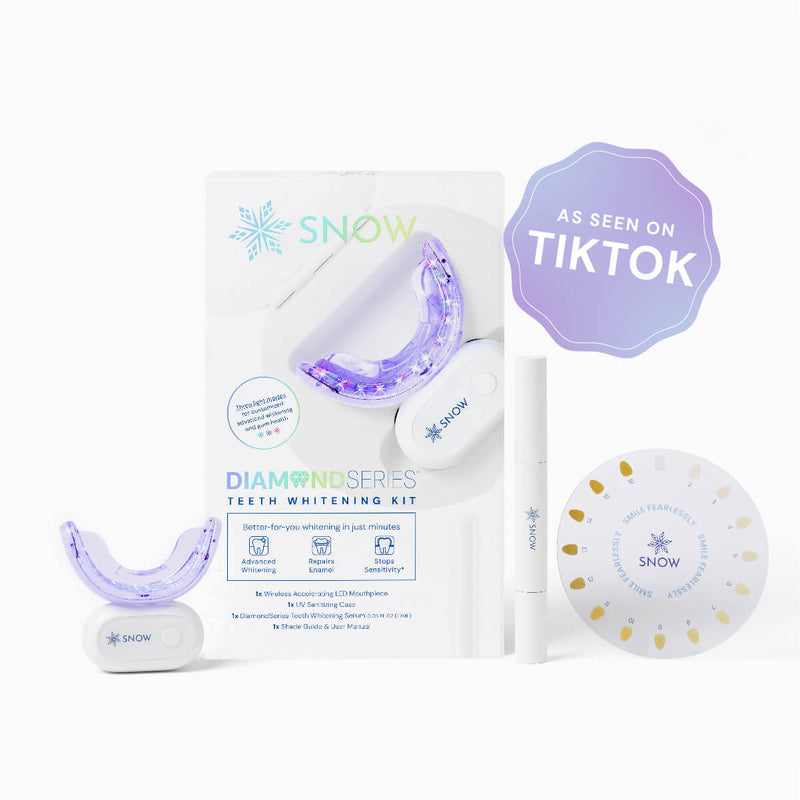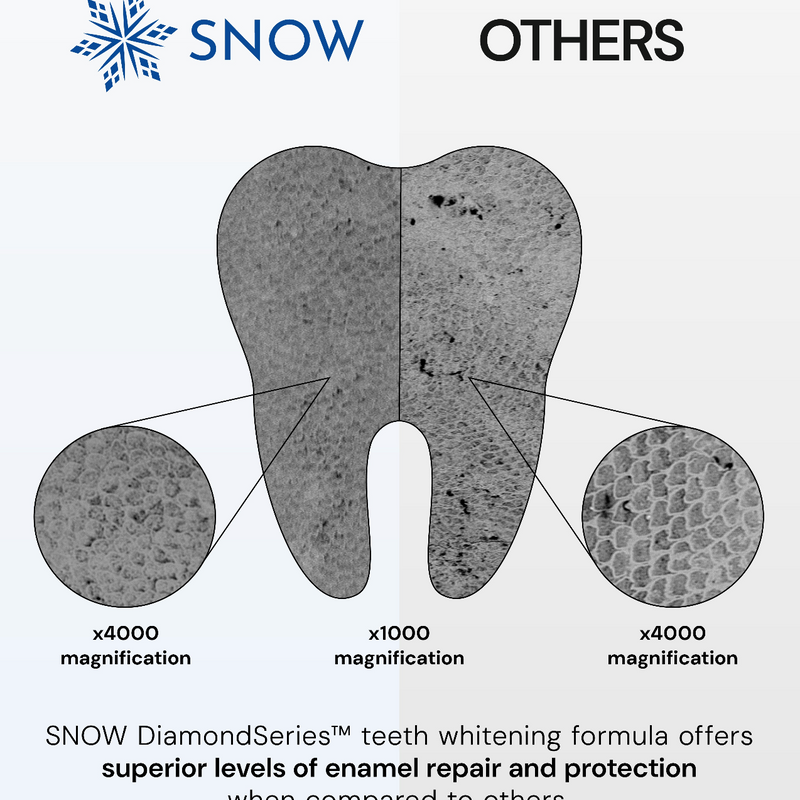Whitening strips are a type of teeth whitening product that is an over-the-counter treatment and are used to whiten teeth. Stains on your teeth can be removed using substances contained in the strips.
Suppose you have never used the strips to whiten dark teeth before. In that case, you might be curious about how whitening strips work and how to incorporate them into your regular clean teeth routine. People often ask whether you use teeth whitening tape after regularly brushing your teeth, or do you brush immediately before use?
After utilizing the strips, you can brush your teeth, but you should keep a few things in mind. Using caution and brushing gently while using whitening strips is crucial to avoid gum irritation from the whitening agent in the bleach strips.
Here are some of the most effective ways to brush your teeth and use whitening teeth strips so that you may have a brighter smile and help prevent tooth sensitivity. In addition, we will discuss the operation of the strips for whitening teeth and any potential adverse effects they may have.
How do whitening strips function?
Hydrogen peroxide active ingredient whitening strips are thought to be better for helping minimize gum irritation, and bleach is considered a slightly harsher compound used in teeth strips. As a result, they function similarly to whitening your clothing or hair. Hydrogen peroxide removes color from your teeth, returning them to their natural state.
Most strips are constructed of polyethylene, a thin layer of an elastic film. This film is peroxide-coated, with some strips containing more peroxide than others. You then apply the strips to your teeth as directed on the packet, allowing the peroxide to come into touch with your tooth enamel. This permits the peroxide to eliminate discoloration and stains from your teeth's surface. Some strips must be removed after a specified period, while others do not.
However, one drawback of these strips is that if you have cracked teeth, missing teeth, or crooked teeth, it can be challenging to get the strip to sit evenly to get the brightest smile possible.
The Advantages of Whitening Strips
The most significant advantage of teeth bleaching strips is that they are more economical than some other methods of teeth whitening, such as custom-fitting whitening trays. Most home whitening kits are less expensive than visiting the dentist to have a professional teeth whitening process. Strips are often affordable since they are constructed of low-cost components; plastic and hydrogen peroxide gel as an active whitening agents are relatively inexpensive to produce for a whitening process.
In addition to being inexpensive, the best whitening strips are simple to use. Many kits include two sets of strips. The top teeth have one set, and the lower teeth have another. The box also contains instructions on how long you should leave the strips. You usually have to put them on twice daily for around two weeks.
Finally, whitening strips provide immediate effects. Your teeth should start to whiten after a few days of applying the strips, with some of the best strips making teeth whiter possibly overnight, and the effects should last at least four months.
After using whitening strips, do you brush?
You can brush your teeth after using whitening strips, although doing so is not required. This is the standard recommendation. If you choose to clean your teeth immediately after removing the white stripes, make an effort to do so gently. If you have access to one, use a brush with bristles on the softer side.
Even if you aren't receiving a tooth whitening procedure, making it a point to brush your teeth with extreme caution can help you prevent irritating your gums and teeth when removing food debris. This is especially important if you have susceptible teeth.
Should you brush your teeth before whitening strips?
It would also help if you brushed your teeth before applying whitening strips. However, there is some conflicting information, and you should follow the manufacturer's directions. Many whitening products suggest toothpaste for sensitive teeth or a whitening gel for the best results.
Some people recommend brushing your teeth before using strips to remove any plaque that may prevent the whitening strips from attaching correctly and to remove the sticky surface layer of plaque that may prevent the whitening effects from being optimal.
Others argue that white strips will stay on better if you don't clean your teeth first and that brushing your teeth just before treatment may cause more irritation during the whitening procedure.
Others suggests that if you clean your teeth before you use whitening strips, do it gently and wait at least 30 seconds after brushing before applying the strips. The theory is that if you put on the white strips immediately after brushing, without waiting the 30 seconds, you risk causing more irritation. Whitening strips are not harmful to the teeth. However, they might cause temporary irritation.
Snow Magic Whitening Strips®
The Magic Whitening Strips® offer a cool mint and lavender scent. In their list of Frequently Asked Questions, Snow includes a query about brushing teeth and using strips. The query is:
"Do I need to brush my teeth first before applying the Magic Strips?"
Snow's response is:
"You are not required to brush your teeth before the treatment, but doing so may help remove excess buildup."
Snow does not recommend brushing your teeth immediately after using the whitening strips. This is because these strips disintegrate immediately on your teeth in only 15 minutes, leaving no sticky mess and no need to clean your teeth. However, you must wait 15-30 minutes before eating or drinking and limit acidic foods such as fruit juice.
Whitening strip side effects
Although teeth whitening strips are easy, the substances might damage your teeth and gums.
Numerous factors determine the degree of adverse effects, including:
- Peroxide bleach concentration
- Other product components
- How long do you use the whitening strips?
- Your history of tooth sensitivity
It is critical to follow the directions on the label and avoid wearing the strips for longer than indicated.
Sensitivity of the teeth
Whitening strips include ingredients that might make teeth even more sensitive. This happens when peroxide passes through your enamel to your dentin.
The dentin is a soft tissue layer under your enamel. It is made up of tubules connecting with the tooth's nerves. Carbamide peroxide can irritate nerves and induce tooth sensitivity if it reaches the dentin.
Sensitive teeth induces discomfort due to a variety of factors, including:
- Acidic foods and beverages
- Liquids that are hot or chilly
- Flossing in cold air
Tooth sensitivity caused by whitening strips might last for many days. It is, however, typically only brief. If you experience this adverse effect, stop using the strips for a while before resuming use. You should visit your dentist if you continue to feel pain beyond a few days.
Irritation of the gums
Peroxide in these strips may hurt your gums as well. This frequently occurs when the strips are worn improperly or for an extended period.
Gum inflammation, like tooth sensitivity, can persist for 2-3 days but is also transitory.
Tooth decay
Whitening strips might cause tooth damage in rare circumstances. The peroxide may cause demineralization and erosion by destroying the layers of your teeth.
This is especially common if you use whitening strips excessively. Again, avoiding wearing tooth strips for an extended period is preferable.
How to keep your teeth white
Whether you've had teeth whitened or are blessed with naturally white teeth, there can be actions you can do to minimize future yellow teeth:
-
Brush and floss daily to keep your teeth healthy. This can help limit bacteria and plaque development, contributing to tooth discoloration and improving oral health.
-
Avoid smoking cigarettes since it may drastically lead to dark teeth and raise your risk of cancer and gum disease. Avoiding or stopping smoking can significantly help guide you to a whiter smile.
-
Rinse your mouth after consuming staining liquids: Dark liquids, including coffee, hot chocolate, tea, and red wine, can cause tooth discoloration. In between swallows of these drinks, gently rinse your mouth with water.
-
Maintain regular dental cleanings: Have your teeth professionally cleaned twice yearly by a dentist. The dentist will scrape off tartar and polish your teeth, aiding in the fight against discoloration.
How can I remove the whitening gel from my teeth?
You may be afraid to clean your teeth shortly after whitening if you have sensitive teeth and gums. However, most whitening strips leave a significant amount of whitening gel behind. So, how do you get this off if you don't brush straight away?
Begin by washing your mouth and swirling the water around your mouth thoroughly. That will remove most of the gel, but some stubborn particles may remain, particularly in the crevices between teeth.
If this is the case, you can gently wipe the gel away with your fingers if you aren't ready to brush softly with a toothbrush.
Whitening toothpaste to supplement your regimen
Whether you should brush teeth after using strips, you might want to supplement your tooth whitening practice with an electric toothbrush designed to clean and whiten teeth. Brush your teeth before applying white strips.
The best brush for getting the best outcome is Snow (of course!)
Brushing with the LED electric toothbrush
Snow is well-known for its at-home whitening kits, which produce professional effects and the aforementioned Magic Strips. They now manufacture an excellent LED electric toothbrush as well. This is one of the few toothbrushes that combines LED technology with their sonic technology for improved cleaning and whitening.
Along with LED whitening assistance, this brush has all of the convenient features we've come to expect from our electric toothbrushes, such as:
- Timer for two minutes with a 30-second quadrant alert
- There are four brushing modes
- Battery life is extended
In addition, Snow has whitening pens for sensitive teeth, which dentists recommend more often than many other whitening pens.
When to consult a dentist
Consult a dentist before you use over-the-counter teeth whitening solutions such as strips.
This is especially critical if you have any of the following:
- Cavities
- Tooth sensitivity due to gum disease
- Canker sores and cold sores
- Missing or crooked teeth
If you have missing or crooked teeth, you may want to consider replacing missing teeth or straightening crooked teeth before using strips to whiten dark teeth.
The components in whitening creams may cause discomfort if you have any of these disorders.
Your dentist can tell you whether whitening strips are best for you. They can advise you on the best solutions and show you how to utilize them. They could also recommend kinds of toothpaste and electric toothbrush refill heads compatible with whitening strips.
Summary
Brushing your teeth after using whitening strips is safe. Just remember to be gentle so as not to irritate your gums.
Brush your teeth beforehand before applying whitening strips. Brushing is good for eliminating plaque that has been lodged underneath the strips. Wait 30 minutes before you apply strips to avoid irritating your gums.
Always follow the manufacturer's and dentist's instructions when getting ready to use whitening products. Too long using them might cause dental sensitivity, tooth damage, and inflammation. Your dentist can advise you on your specific scenario's most delicate whitening strips.


























